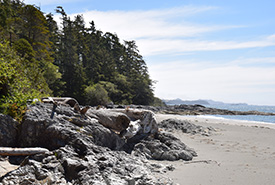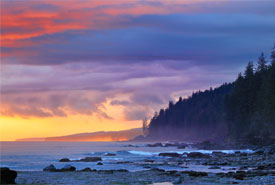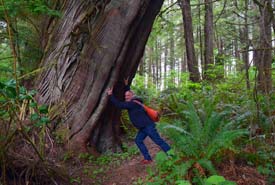Clayoquot Island Preserve
Due to the elevated wildfire risk across British Columbia, some of NCC’s conservation areas are currently closed to public access. Please check our Current Fire Closures page for more information.

Clayoquot Island's rocky shores (Photo by NCC)
Clayoquot Island sits like a pearl in the mouth of Vancouver Island’s most famous wilderness area: Clayoquot Sound. The island, which is labelled Stubbs Island on nautical charts, is a short boat ride from the popular tourist town of Tofino. Situated within the Clayoquot Sound UNESCO Biosphere Reserve, Clayoquot Island is a rich mosaic of forest, beach and ocean habitats.
Clayoquot Island was donated to the Nature Conservancy of Canada (NCC) by its longtime owner, who wanted it kept as a nature preserve for the long term.
The Clayoquot Island Preserve spans 44 hectares (108 acres) of mixed old-growth and mature second-growth coastal western hemlock forest. On the oldest parts of the island, 300-year-old western red cedars tower above the forest floor, their moss laden branches offering ideal nesting habitat for the provincially at risk marbled murrelet. The forest also supports dense thickets of California wax-myrtle, a provincially threatened species found only in the coastal regions between Ucluelet and Tofino.
The island’s beaches and intertidal areas support two critical habitats for conservation: coastal sand dunes and eel-grass beds. Over 85 hectares (210 acres) of eelgrass grow just off the rocky shores of Clayoquot Island. These sea meadows store carbon at a capacity greater than a tropical rainforest and provide a haven for juvenile fish species looking for cover. They are also an ideal spawning ground for Pacific herring, which are a substantial food source for coastal birds and mammals.
Great blue heron, black oystercatcher and Pacific geoduck can be found in the area. Clayoquot Island is an important migratory stopover for the hundreds of Brant geese that feed and rest on the sandspit in the early spring.
A landowner’s vision

Clayoquot Sound (Photo by Tim Ennis/NCC)
Susan Bloom purchased Clayoquot Island in 1990, when the previous owner's plans to subdivide and develop the island with hundreds of vacation homes fell through. With the island in foreclosure and the potential for development high, Susan jumped at the chance to protect Clayoquot as a place of nature and prevent further development of the island’s hemlock forests and white sand beaches. She established the Clayoquot Island Preserve and allowed the forested parts of the island to flourish.
“From the very first time I visited and then became the owner of Clayoquot Island, my goal has been to protect the island from any more development, to preserve it in its natural wild state and to remove years and years of accumulated human garbage and refuse,” said Bloom. “My recent lifetime goal is to see that this beautiful land, steeped in Canadian history, be placed into safe conservation hands and cared for in perpetuity. The Nature Conservancy of Canada has a sterling reputation in the field of land protection. I am delighted that they have accepted this responsibility.”

Clayoquot Island Preserve, BC (Photo by NCC)
A rich and storied history
Clayoquot (Stubbs) Island has been used for millennia by the Nuu-chah-nulth people. It is within the traditional territory of the Tla-o-qui-aht First Nation.
In the mid-1800s, Clayoquot Island was the site of the earliest fur-trading post on the west coast of Vancouver Island. The town, known as Clayoquot, grew to include a hotel, beer parlour, post office, school and dozens of homes in the early 20th century. It was eventually de-populated, as nearby Tofino surpassed Clayoquot as the main town centre in the area.




